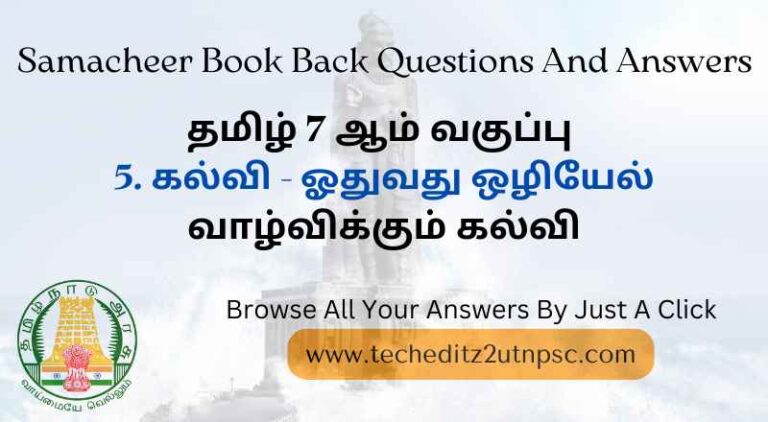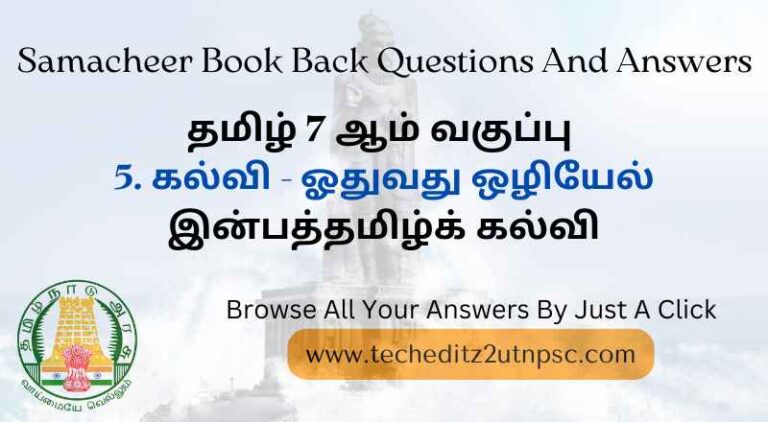support@techeditz2utnpsc.com | 8300-921-521
Interior Of The Earth
Samacheer Book Back Questions And Answers For Geography Standard 7 Term 1 “Interior Of The Earth”
I. Choose the correct answer:
1. Nife is made up of _____.
a. Nickel and ferrous
b. Silica and aluminum
c. Silica and magnesium
d. Iron and magnesium
2. Earthquake and volcanic eruption occur near the edges of _____.
a. Mountain
b. Plains
c. Plates
d. Plateaus
3. The magnitude of an earthquake is measured by _____.
a. Seismograph
b. Richter scale
c. Ammeter
d. Rotameter
4. The narrow pipe through which magma flow out is called a _____.
a. Vent
b. Crater
c. Focus
d. Caldera
5. Lava cones are _____.
a. mountains of accumulation
b. mountains of deformation
c. relicit mountains
d. fold mountains
6. The top of the cone of a volcanic moun¬tain has a depression known as the _____.
a. Crater
b. Lopith
c. Caldera
d. Sill
7. _____ belt is known as the “Ring of Fire”.
a. Pacific
b. Atlantic
c. Arctic
d. Antarctic
II. Fill in the blanks:
1) The core is separated from the mantle by a boundary called _____.
2) The earthquake waves are recorded by an instrument known as _____.
3) Magma rises to the surface and spreads over a vast area is known as _____.
4) An example for active volcano _____.
5) Seismology is the study of_____.
Answers:
1. Weichart – Gutenberg discontinuity
2. Seismograph
3. Fissure eruption
4. St. Helens USA
5. Earthquake
III. Circle the odd one:
1) Crust, magma, core, mantle
2) Focus, epicenter, vent, seismic waves
3) Uttar Kashi, Chamoli, Koyna, Krakatoa
4) Lava, caldera, silica, crater
5) Stromboli, Helens, Hawaii, Fujiyama
Answers:
1. Others layers of earth
2. others are related to earthquake. Vent – Volcanoes related
3. 3 are in India. Krakatoa – Indonesia
4.
• Lava: The term lava refers to the molten solid magma that is spread on the surface of the earth.
• Crater: It refers to the funnel-shaped depression that occurs on the top of the cones.
• Caldera: The basin-shaped depression is known as the Caldera. They are the outcome of Violent eruption which blows from the top of the cone.
• Silica: The viscosity of the lava is determined by the amount of silica and water present.
5. Mt. Fujiyama is an example of a dormant Volcano. Others active
IV. Match the following:
1) Earth quake A. Japanese term
2) Sima B. Africa
3) Pacific Ring of Fire C. Sudden movement
4) Tsunami D. Silica and magnesium
5) Mt. Kenya E. World volcanoes
Answers:
1. C
2. D
3. E
4. A
5. B
V. Consider the following statement and choose the appropriate answer:
1. Assertion (A): There structure of the earth may be compared to that of an Apple.
Reason (R): The interior of the earth con¬sists of crust, mantle and core.
a. A and R are correct and A explains R
b. A and R are correct but A does not explain R
c. A is incorrect but R is correct
d. Both A and R are incorrect
2. Assertion (A): The Pacific Ocean includes two thirds of the world’s volcanoes.
Reason (R): The boundary along the Eastern and Western coast areas of the Pacific Ocean is known as the Pacific Ring of Fire.
a. A and R are correct and A explains R
b. A and R are correct but A does not explain R
c. A is incorrect but R is correct
d. Both A and R are incorrect
VI. Answer in a word:
1) Name the outer most layer of the earth.
2) What is SIAL?
3) Name the movement of the Earth’s lithospheric plates?
4) Give an example of extinct volcano
Answers:
1. Crust
2. The upper part of the crust
3. Tectonic movements
4. Mt. Kilimanjaro and Mt. Kenya in Africa.


